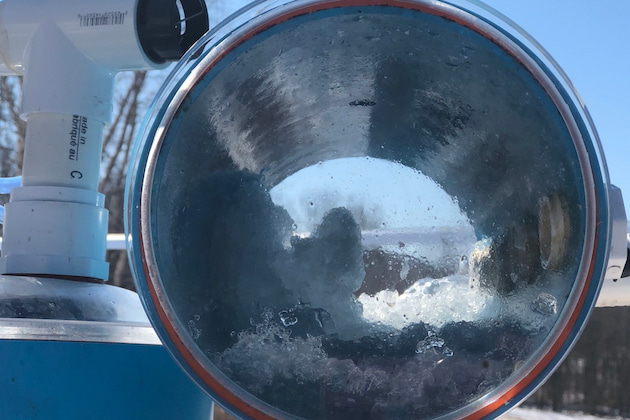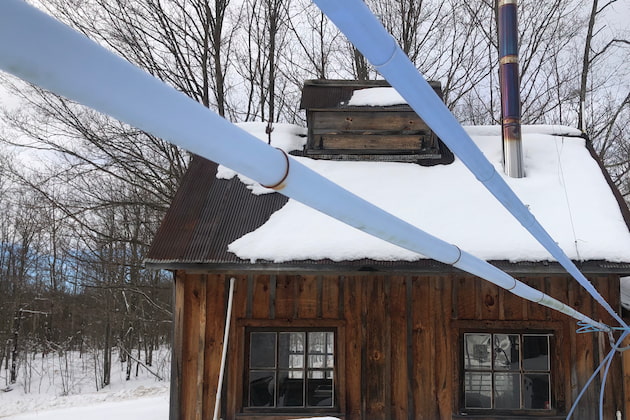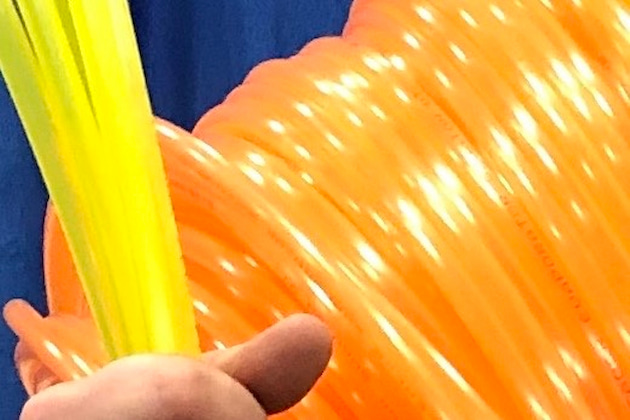Cornell Corner
Maximum sap 101
Cornell webinar reviews the fundamentals of sap production
By PAUL POST | FEBRUARY 10, 2021
LAKE PLACID, N.Y.—More taps doesn’t necessarily mean more sap.
Some factors such as climate, elevation, tree health and size, and surrounding species composition are beyond a sugarmaker’s control.
But understanding how they impact production, and learning how to work with them, can prove quite beneficial.
This plus adhering to good tapping practices and having a well-designed system is the perfect recipe for a smooth-running, efficient and profitable operation, said Adam Wild, director of Cornell University’s Uihlein Maple Research Center in Lake Placid, N.Y. during a maple seminar last month.
Wild’s webinar, “Maximizing Production in Your Sap Collection System” was the sixth and final segment of an online introductory course for new and beginning sugarmakers.
However, the session had valuable reminders for veteran maple producers as well.
“Not every sugarbush has equal production potential,” Wild said. “If you’re not producing as much as you think you can I’m sure there’s lots of room to increase production. This is going to differ from region to region, state to state, but also can change locally.”
With this in mind, many things are within a producer’s control that he or she can do to enjoy improved results, he said.
Specific areas to focus on are good tapping techniques, timing of tapping, spout type and sanitation, tubing type and sanitation, maintaining high vacuum at the tap hole, and tubing design layout.
“More taps does not always equal more sap, but always equals more work,” Wild said. “Yes, in theory the more taps you have the more sap you’re going to collect. But if you increase from 6,000 to 8,000 taps, for example, that doesn’t necessarily mean you’re going to have a huge increase in the amount of sap that you collect.
“If you don’t have enough labor out there to maintain that system in your woods, it could be less efficient and you’re going to get less sap than if you had just 6,000 taps,” Wild said.
Quite simply, a manageable number of taps can be more productive than just putting out a large number.
“I’m not saying you shouldn’t put out a large number of taps, but make sure you have the ability to keep up with it,” he said.
This holds true for processing, too.
“Make sure you’ve got the ability to store all that sap in your sap tanks so it’s not going to overflow on you,” Wild said. “You want to be able to process it on time. These are other things to think about if you’re expanding.”
Small operations with only a few hundred taps probably don’t need a vacuum system because smaller diameter 3/16-inch tubing creates its own vacuum in the lateral line.
But this type of gravity-fed system requires at least a 30-foot drop in elevation to have high vacuum.
“With a full column of sap in the tubing, when it drops in elevation the weight of it creates vacuum,” Wild said.
But for any other sized operation, the best and most effective way to increase production is putting a vacuum on the collection system.
In combination with good tubing design, this can yield “two to three times more sap if we keep high vacuum,” he said.
However, vigilance is required.
“Make sure you’re spending time out in the woods checking the system for vacuum leaks, whether it’s in the tubing or around the tap hole,” Wild said. “Don’t just look at the vacuum that’s on your pump, releasers or tank taps, but what’s at the end of the line at the tap on the tree. And make sure your system is large enough to handle the capacity of sap and air removal, so you can maintain high vacuum.”
It’s critical to select the right size tubing, which is primarily based on the distance involved.
“The farther out you go the more friction and loss you’re going to have,” he said. “Imagine running down a hallway and needing to make a 90-degree turn or running through crowd bumping people. It’s the same thing with sap and air. In a small pipe it can’t get out as quickly because it’s bumping up against the walls of the tubing, so we have to size our tubing correctly based on the distance.”
An increase in tubing size is one way to keep sap and air flowing freely, with high vacuum.
For bigger operations, separate sap (wet) and air (dry) lines are preferable because anything larger than two-inch diameter tubing is difficult to work with and fittings are more expensive.
Dedicated sap (wet) and air (dry) lines are cheaper and easier to work with in the long run.
Wild also spent considerable time discussing different sanitation practices and options.
Spouts should be replaced each year, which alone accounts for a roughly 30 percent increase in production.
In addition, drop lines should be replaced every three years.
Wild recommended doing this on a rotational basis with different colored tubing, so one-third of drop lines are replaced each year.
If drop lines are three years or older, it’s best to use check-valve spouts.
These have a little ball in the spout that prevents sap in the tubing system from being sucked back into the tap hole when the tree is freezing up, which can bring in bacteria and yeast that builds up and restricts sap flow.
“It’s going to cost a little more, about 25 cents per spout, but that return on investment is pretty substantial,” Wild said. “You gain more than $2 (worth of sap per tap) by spending an extra 25 cents. That’s a pretty good return on investment in a pretty short period of time.”
He also briefly discussed proper tapping techniques, pointing out that it’s important to drill into clean wood, and use a tapping pattern to avoid hitting old tap hole areas.
“Also, it’s essential to have a good round hole so you aren’t creating any vacuum leaks, and make sure you aren’t over-tapping trees especially if they’re older trees. You don’t want to be tapping trees that aren’t that healthy.”
A webinar participant asked if it’s worth the effort to tap trees located on a colder, northward facing slope.
Cornell Maple Specialist Aaron Wightman, who works at Cornell’s Arnot Forest near Elmira, N.Y., said, “Sugaring is a climate-dependent exercise. That includes the microclimate within your sugarbush. The amount of sunlight exposure can be very different between a northwest and northeast facing slope. You could have a northwest slope covered with hemlocks that further shades your tubing and diminishes sap flow on those borderline days when it’s only a little bit above freezing. But if you have a northeast facing slope that has beech and other hardwoods without that dense shading, you would have a very different microclimate.”
“Having a diversity of microclimates within your sugarbush will diminish risk during the season and even out sap flows,” he said. “Instead of getting big flows and an early finish to the season if everything faces south, if you have different slopes and aspects you’ll get a more spread out sap flow, which is kind of nice because it spreads out the work and kind of evens out sap quality throughout the season.”
Wild said it’s a good idea to thin evergreen trees where mainline tubing is located to let sunlight in and allow lines to thaw out. Frozen sap prevents sap flow.
If possible, he also suggested isolating lines on northward facing slopes where the season is apt to last a week or two longer. This keeps good sap from getting mixed with poor-quality, buddy sap from southern slopes where the season started earlier and is already ending.
“If you’ve got the woods and want to add more trees on northward slopes, I would definitely say go ahead and tap them,” Wild said.
Recently, Wild conducted research in an attempt to determine the best time to tap trees based on changing weather patterns.
Research conducted outside of northern New York indicated that tapping for early sap runs and re-tapping later in the maple season could potentially increase syrup production yields by at least 20 percent or $6 per tap profit.
But Wild’s project, funded by the Northern New York Agricultural Development Program, concluded that re-tapping is not cost-effective or worthwhile because of the extra expense involved with such work, primarily for materials.
Waiting to tap trees closer to the start of the season showed to be more effective for increased sap production.
To view the report go to: https://www.nnyagdev.org/index.php/mapleforest/maple/.


































